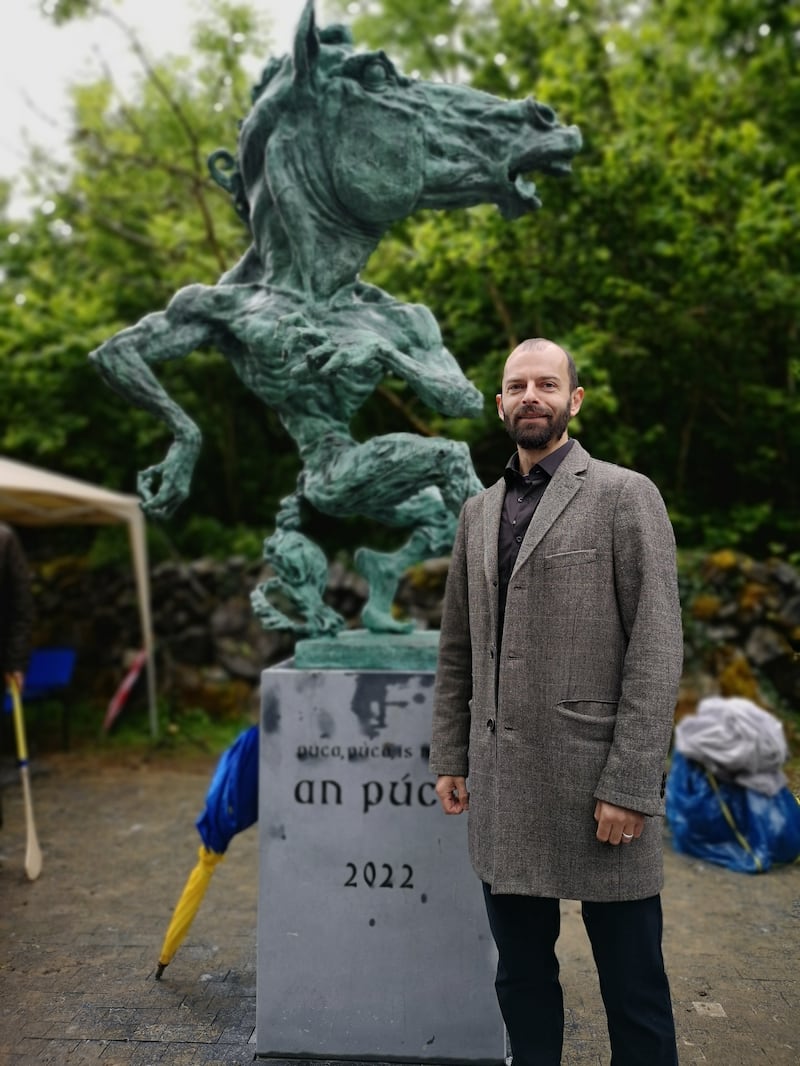As the curtain was pulled on Aidan Harte’s Púca sculpture in Carron, Co Clare, it felt like a fitting end to an exceedingly tall tale.
And what a story it was. Townspeople up in arms, media frenzies, petitions on the streets and celebrity tweets. If you wanted a row about public art, Clare was the place to go.
Like all good fairy tales, there were protagonists and adversaries, heroes and anti-heroes and one big obstacle for the main character to overcome — finding a place where he belonged.
Ultimately Harte’s Púca, commissioned by Clare County Council as a tourist attraction for Ennistymon, was rejected on various grounds by locals when put to a public survey. Whether for reasons of ugliness or superstition, the writing was on the wall for the statue, which was banished from the town.
But there’s a happy ending — and after much debate, the Púca has been welcomed in the village of Carron, some 20km away in the heart of the Burren. Part of the Cusack Centre, the Púca will reside at the childhood home of GAA founder Michael Cusack. As destiny would have it, the statue is in a small townland called Poulaphouca — the Púca’s lair. Was it always meant to be?
As the Púca was unveiled, lone piper Blackie O’Connell played Port na bPúcaí in his honour. Throughout this year-long saga, one thing has remained constant — Harte’s ambition to finish the piece.
“It’s hard to believe,” he says. “The main thing I’m delighted with is to see people all around it, and they’re not running for the hills, they’re not screaming, their hair hasn’t turned white. It’s a dramatic, whimsical statue and now people can see what he is and see he isn’t Beelzebub come back.”
Harte hopes his sculpture will convey “the wild spirit that is in the original stories of the Púca”.
“They’re funny stories with a bit of an edge and they were a way for people to talk about nature and how uncontrollable it is. Now the Púca’s stories are back in currency again”.

Equally enthused was Dónal Ó hAiniféin, head of the Michael Cusack Centre board. “The Púca has arrived, he’s installed and he’s looking smashing. He’s a beautiful kind of a sea green. Everybody thinks that he’s going to be very happy in his new home.”
He added: “Cusack was a bit of a trickster himself — after establishing the Cumann Lúthchleas Gael, it only took him a couple of years to fall out with everybody. And maybe he took the country on a bit of a rollercoaster ride, like the Púca, when he established the GAA and it took off, in his own words, like a prairie fire.”
Cusack established the GAA on the first day of the Celtic new year — also Púca’s Day. “That was no accident that November 1st was the day he chose for that famous meeting at Hayes hotel.”
Mr Ó hAiniféin feels that the statue’s new home will offer an opportunity for people to rediscover the heritage and the stories around the Púca.
“There’s a bit of a revival happening now around St Brigid’s day. With the revival in music and dance and language that has happened, I think the next great revival is around these stories and sagas. I can see Hollywood films based on the Táin and Cúchulainn and Gráinne and Granuaile happening over the next 20 or 30 years.” he said.
And wouldn’t it be great if Hollywood came to Carron?
“Well, tá fáilte rompu.”
Call it mischief, call it fate, but the Púca has wedged himself firmly into the back garden of one of the most famous legacies of Ireland. By way of the back roads and country lanes of the Burren, he may have just found his way home. And all the divilment he caused en route? That’s another story!










